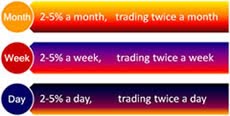Looking
at a chart, you always know in retrospect that prices moved sideways, but how
to know in advance?
In
the NeverLossTrading concept, we integrated a study, which measures changes in
implied volatility and informs the trader by painting a "Purple Zone"
on the chart, indicating, that the
price/volume development of a share has reached this critical stage of consolidation.
Then, we either apply short term sideways strategies, or wait for the breakout
signal, to trade along with the direction after the breakout.
In
the “Purple Zone”, we find little directional movement with various counter
price trend activities until a breakout to the up- or downside occurs. To
support the visibility of such price development, we shade the price chart for
the time-period purple and produce a very powerful indicator, signifying:
-
Apply
short term sideways strategies, with limited risk or do not to initiate trades when
the Purple Zone continues, by not knowing when it ends and in which direction
prices might breakout.
-
Trend-trade
when the Purple Zone is over, if the first candle outside the Purple Zone shows
an arrow pointing to the trade direction:
o
Purple
Arrow: To the upside
o
Purple
Arrow: To the downside.
GE Daily Chart
At
times we get asked why the zone is purple?
The
answer is: It marks a time-zone of indecision where the market forces negotiate
until an upside or downside price-move concludes the decision making process.
The color purple is achieved by mixing red (down-color) and blue (up-color).
For
the beginning financial market investor, the best is not to trade in the
“Purple Zone”, but right after, when a trend is established.
More
advanced traders gauge the price range in the zone and take trades already at
the first break out. By being aware that even light-tower-candles that occur
can quickly be reverted while the “Purple Zone Indicator” is present.
If
we are in a trade that enters a “Direction Change Zone”, we either exit the
trade or adjust the range for the stop not to be taken out by radical price
movements. If we are unwilling to accept additional risk and still want to stay
in the trade, the stop line (red line) of the Double-Decker at entry into the
“Purple Zone” builds the point where we put our stop.
A
directional arrow after the Purple Zone identifies a high probable trade entry.
If
there is no arrow on the first candle after the Purple Zone, the study
recommends not to enter into a directional trade.
The
best trade entry for a trend trade is two ticks above/below the trade proposal
painted on the chart.
The
same functionality applies for Intra-Day-
and Swing-Trading Charts. After
our new software update, we are now allowing in the NLT-Purple-Zone-Indicator
to put a computer generated price proposal at the end of the Purple Zone
arrow:
SPY Hourly Chart
The
trade direction-pointing arrow after the Purple Zone now resides on the price
level of the cloud and identifies the new price direction to trade.
The
width of the cloud can be adjusted from the factory setting of 2 to a higher or
lower level:
If
the level is set to zero, the Purple Zone Cloud disappears.
If
it is set to 1, it narrows the width of the cloud.
A
setting above 2 widens the cloud setting.
Further:
The alert sound and the end of Purple Zone alert can be set to individual
preferences.
Additional Switch
Functions:
-
If
you want the computer generated trade proposal, set the switch on “Yes”.
-
To
receive a sound alert, when the End-of-Purple-Zone -Indicator is triggered, put
the switch on “Yes”.
The
“Purple Zone Indicator” is an integral
part of our software package. See, how you can integrate it in your trading. We
offer four mentorship programs, geared to the need of the individual Investor:
- NLT Top-Line, for the Independent investor, where we install real-time analysis software.
- NLT HF-Stock-Trading: For frequent traders, able to trade the markets every day.
- NLT Wealth Building: If you are trading two times a week/month.
- NLT Income Generating: For day-trading futures and options.
Schedule
for a private consultation: contact@NeverLossTrading.com










